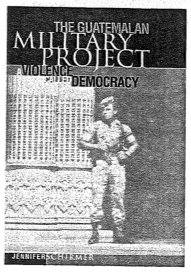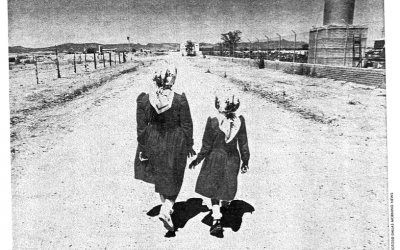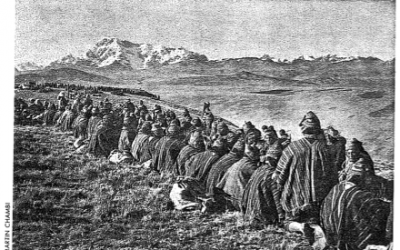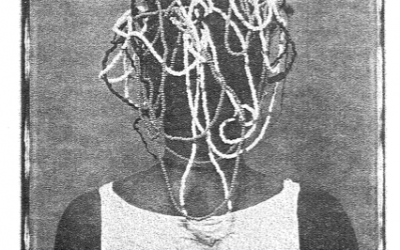A Review of A Violence Called Democracy

The Guatemalan Military Project: A Violence Called Democracy, by Jennifer Schirmer, University of Pennsylvania Press, 1998
As any journalist or diplomat who has spent time in Guatemala will attest, no group there is more difficult to penetrate than the Guatemalan Armed Forces. As much a caste as an institution, the military distrusts outsiders and is reluctant to deal with them. There is ample reason for that, of course: as one human rights reports after another has detailed, officers and soldiers ordered and carried out the vast majority of the estimated 200,000 killings and disappearances that took place during the country’s 36-year civil war.
Given that record and the wariness that accompanies it, Jennifer Schirmer’s “The Guatemalan Military Project: A Violence Called Democracy” is a remarkable achievement. Over a period of a decade, she succeeded in getting more than 50 Guatemalan officers, from generals at the Ministry of Defense to sergeants out in the field, not only to agree to interviews that directly addressed these issues but to speak with uncustomary candor about their actions, their beliefs and their relations with forces ranging from civilian Guatemalan politicians to the American military and intelligence establishment.
The central figure in Schirmer’s treatment of what she rightly calls “the most powerful, least researched and least understood institution in Guatemala” is Gen. Hector Gramajo Morales, whom she interviewed 14 times during a five year period. As Minister of Defense between 1987 and 1990 and Deputy Chief of Staff and self-proclaimed “granddaddy” of Guatemalan intelligence before that, Gramajo played a leading role in first supervising the formal transition to civilian rule and then fending off a coterie of high-ranking officers who were unwilling to cede even the appearance of power in order to retain its essence.
Loquacious but canny, Gramajo argues that in Guatemala, von Clausewitz’s famous dictum works in reverse: “politics must be the continuation of war.” Schirmer shows how Gramajo and other so-called “institutionalists” pushed for a system of “co-governance” that would grant compliant civilians just enough authority to argue abroad that Guatemala was in a democratic transition while simultaneously forcing those nominally in power to share the blame for the human rights abuses the military carried out.
“To interpret this opening as anything other than the army’s intent to confuse responsibility with blame without granting the President power would be naive,” Schirmer concludes. Or as Gramajo himself puts it, “my insurance is that my jefe knew everything. If there is something has been omitted or committed, it’s not my responsibility, then, it’s his.”
Schirmer also introduces us to such important yet little-known figures as Col. Manuel de Jesus Giron Tanchez, private secretary to the country’s last two military heads of state. A lawyer by training, Giron Tanchez worked behind the scenes as a “legal architect” to draft the statutes that embedded the military’s supremacy in the current Guatemalan Constitution, thereby limiting the power of the four civilian presidents who have governed the country since 1986, including the current head of state, Alvaro Arzu Irigoyen.
I have covered Guatemala on and off since 1980, but until reading Schirmer’s chapter on “A Military View of Law and Security” had not properly appreciated the importance the Guatemalan military attached to putting a legal gloss on its depredations and creating a system in which “emphasis is on the law as sanction rather than a system of rules.” It is this “appropriation of the imagery of the rule of law, of the mechanisms and procedures of electoral democracy, that is perilous to human rights of Guatemalans,” Schirmer notes.
Indeed, Schirmer’s interviews make clear that the entire Guatemalan military is afflicted with a severe case of cognitive dissonance, as might be expected of a force which pursued a policy she describes as “pacification by way of massacre.” Anyone who dissents from the military project, such as unions or human rights groups, is seen, ipso facto, as a subversive or delinquent who must be eliminated. Even “when political parties did try to organize, they were seen as ‘disruptive’ to ‘the democratic project’,” Schirmer points out.
Most chilling of all, however, are the declarations of “Filo,” a longtime member of G-2, Guatemalan military intelligence. In an extraordinary interview that is cited several times in the main text and then published in much longer form as a separate appendix, this mid-level functionary of the state security apparatus strips away all the abstract language his superiors employ, and ends up acknowledging that the department is first and foremost a killing machine.
“The reason G-2 exists is to kidnap and torture until our subjects are wretched and maimed,” he states. “Then they are assassinated, thrown in a ravine, buried or left by the side of the road. That’s the work we do.” He concedes that “sometimes I would kill a person who was innocent” but then adds: “The fact is that we enjoyed our work. At least that was true for me. I liked it because I brought to it much of the resentment from my earlier life.”
From their comments, Schirmer’s military informants make it clear that the American Embassy and the Central Intelligence Agency knew precisely what was happening and made a conscious choice to look the other way. But Washington’s cynicism was matched by others: when Jimmy Carter sought to distance the U.S. from the government of Gen. Romeo Lucas GarcÃa, advisors and weapons from Argentina, Colombia, Israel and Taiwan quickly poured in to take their place, and the level of violence substantially increased.
Schirmer is writing about a period that ostensibly concluded with the signing of a peace agreement, sponsored by the United Nations, that brought an end to the civil war on Dec. 29, 1996. But the structure of military primacy and impunity she describes lingers on, and her examination of it helps explain why the government investigation into the April 1998 assassination of Bishop Juan Gerardi, a leading human rights advocate, has degenerated into a farce.
Indeed, Col. Byron Lima, named by human rights groups as the main suspect in the murder but ignored by government investigators, figures in some earlier episodes that Schirmer discusses. As if more proof were needed, those recent events buttress Schirmer’s conclusion that “rather than being irrational and out of control,” the leaders of the Guatemalan military and intelligence apparatus “are precisely in control and acting in their own best interest.”
Winter 1999
Larry Rohter was Central American correspondent for Newsweek magazine from 1980 through 1982 and for The New York Times from 1994 through 1998. He is now the newspaper’s Brazil bureau chief, based in Rio de Janeiro.
Related Articles
Linking Latin America
I have captured images of such seemingly disparate subjects as Mennonite immigrants to Mexico, Latina contestants for Selena standings, the Pope in Cuba, and traditional Sunday serenatas…
Researching Latin America
The instant outpouring of Web information on the Pinochet case got me to thinking about communications on my first trip to Chile during the Allende presidency. I was armed for Ph.D…
The Public Face of Cyberspace
Imagine a network that spans the world. A network that delivers — invisibly and inexpensively — the myriad bits of information that will undeniably be the key to prosperity in the 21st century…




